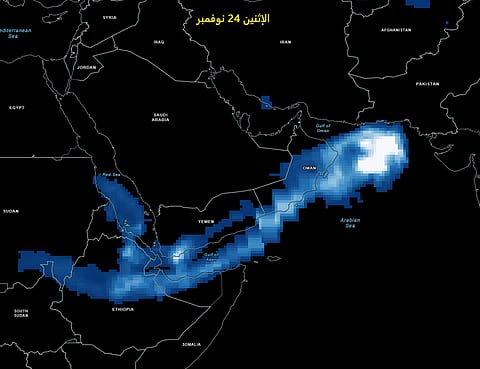Ethiopia volcanic eruption: Sulphur dioxide plume spreads across southern Arabian Peninsula
Satellite shows gas cloud drifting over Yemen and Oman after Hayli Gubbi eruption

Abu Dhabi: The International Astronomical Centre has released satellite images showing a vast plume of sulphur dioxide drifting across the southern Arabian Peninsula following a powerful eruption of Ethiopia’s Hayli Gubbi volcano on Sunday.
The images reveal the volcanic gas spreading rapidly over the region in the days after the blast, raising environmental and atmospheric concerns.
The first image, captured on Sunday shortly after the eruption, shows the initial concentration of SO₂ and the areas directly affected. A second image, taken on Monday, indicates a much wider spread, with the plume extending over large parts of Yemen and Oman.
A similar event in previous years saw the gas reach the region, causing the sky to take on striking violet and reddish hues after sunset. This occurs when the natural blue tint of twilight blends with intense red light scattered by volcanic gases, producing unusual colours and brightness in the post-sunset sky.
The satellite data highlights the density of the SO₂ plume in the lower troposphere at around 2.5 kilometres above ground level, a layer commonly used to monitor volcanic gas emissions.
Sulphur dioxide is one of six major air pollutants regulated by the US Environmental Protection Agency (EPA), alongside ground-level ozone, nitrogen dioxide, lead, and fine particulate matter (PM2.5 and PM10). The gas can irritate the eyes, nose, and lungs, and high concentrations may cause temporary breathing difficulties.
SO₂ is typically produced by burning coal, oil, and fuel, but it can also accumulate in the stratosphere during major volcanic eruptions, contributing to atmospheric and climatic effects.
Sign up for the Daily Briefing
Get the latest news and updates straight to your inbox






